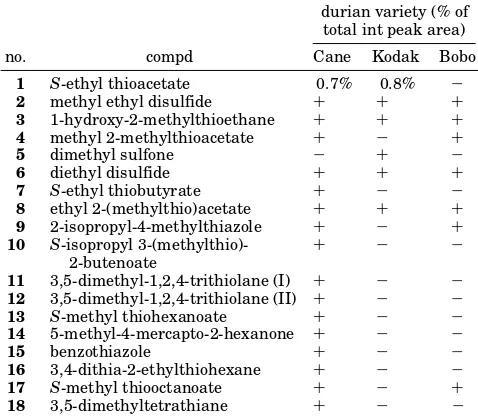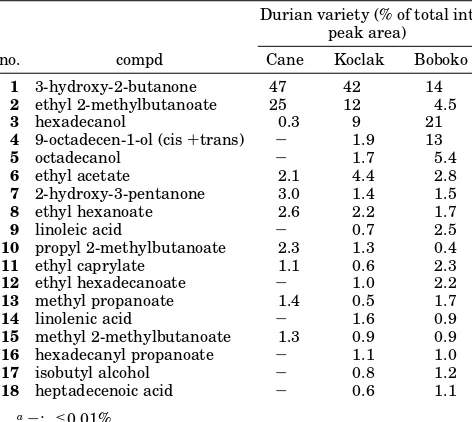Sulfur-Containing Volatiles of Durian Fruits (
Durio zibethinus
Murr.)
Hugo Weenen,*,†Wim E. Koolhaas,†and Anton Apriyantono‡
Quest International, 28 Huizerstraatweg, 1411 GP Naarden, The Netherlands, and Department of Food Technology and Human Nutrition, Bogor Agricultural University, Kampus IPB Darmaga, P.O. Box 220,
Bogor 16002, Indonesia
The fruits of three varieties of Indonesian durian have been analyzed by GC-MS and flavor dilution analysis. Twenty-four of the 43 peaks that contributed to the flavor of the 5×diluted extract, as detected by sniff-GC, had a sulfury note. Upon diluting the original extract 50 times, 11 components of the 17 which could still be detected by sniff-GC had a sulfury note, 3 of which were especially strong. One of the three strongest durian odorants was identified, based on Kovats index, MS, and odor description, as 3,5-dimethyl-1,2,4-trithiolane. Ethyl 2-methylbutanoate was found to have the highest odor impact among the non-sulfurous odorants in durian.
Keywords: Durian; tropical fruit; aroma dilution analysis; fruit flavor; S-ethyl thioacetate; 3,5-dimethyl-1,2,4-trithiolane
INTRODUCTION
There is a considerable interest in exotic fruits, especially those originating from tropical regions, be-cause of their unique and exotic flavors. A very popular tropical fruit, especially in South East Asia, is durian (Durio zibethinusMurr.). The durian fruit is round or oval, about the size of a coconut, with a green, yellowish green, or dark yellow color. It is covered all over with short stout spines and it is usually five-valved, and within each compartment are several seeds surrounded by edible custard-like pulp. The pulp has a strong and unique sulfury odor, a sweet and slight bitter taste, and a white, yellowish white, or dark yellow color. The odor, taste, color, and size of the fruit vary according to the variety of durian, which is more than 100 in number. Ripe durian is eaten fresh, consumed as fresh juice, used in ice cream, or prepared in various other ways.
The flavor of durian is unpleasant to most who are not grown up in South East Asia, but many South East Asians are very fond of the flavor of durian. Durian fruits possess two distinct odor notes, i.e. strong sulfury onion-like and delicately fruity (Baldry et al., 1972).
Baldry et al. (1972), who were the first to report on the volatile constituents of durian, identified a total of 26 volatiles in the distillate of durian fruits from Singapore and Malaysia, which were comprised of 7 sulfur compounds, 12 aliphatic esters, 2 aldehydes, 4 alcohols, and 1 aromatic compound. They noted that durians from different regions significantly differed in composition and that thioesters (unidentified) and 1-propanethiol were mainly responsible for the onion-like odor, whereas ethyl 2-methylbutanoate was found to be a major contributor to the fruity odor.
Moser et al. (1980) identified eight sulfur compounds, mostly dialkyl polysulfides, in the headspace fraction of durian from Thailand, in which diethyl disulfide and diethyl trisulfide were predominant. They also reported that the steam distillate of durian contained ethyl 2-methylbutanoate, 1,1-diethoxyethane, and ethyl ac-etate. In addition, they found that the levels of the main
sulfur compounds increased with maturity, except ethanethiol, which decreased in concentration with maturity.
Wong and Tie (1995) identified 63 volatiles in durian from Malaysia, 16 of which were sulfur containing. Major constituents identified by them included 3-hy-droxy-2-butanone (32-33%), ethyl propanoate (20%), and ethyl 2-methylbutanoate (15-22%). In this report, the composition of the flavor components of three varieties of durian from Indonesia is described.
MATERIALS AND METHODS
Fruits. Durian fruits,D. zibethinusMurr., were obtained from a local market in Bogor, Indonesia, in October 1992.
Extraction. Two hundred grams of the flesh of two ripe durian fruits was extracted using 3 × 300 mL of
dichlo-romethane/pentane (1:1, v/v). The organic phase was concen-trated 10 times by fractional distillation (Vigreux column) at a flask temperature of 60 °C. The extract was dried over MgSO4and concentrated again using a Vigreux distillation
†Quest International.
‡Bogor Agricultural University.
Table 1. Sulfur Compounds in Three Durian Varieties from Indonesia As Identified by GC-MSa
durian variety (% of total int peak area)
no. compd Cane Kodak Bobo
1 S-ethyl thioacetate 0.7% 0.8% -2 methyl ethyl disulfide + + + 3 1-hydroxy-2-methylthioethane + + + 4 methyl 2-methylthioacetate + - +
5 dimethyl sulfone - +
-6 diethyl disulfide + + +
7 S-ethyl thiobutyrate + - -8 ethyl 2-(methylthio)acetate + + + 9 2-isopropyl-4-methylthiazole + - + 10 S-isopropyl
3-(methylthio)-2-butenoate
+ -
-11 3,5-dimethyl-1,2,4-trithiolane (I) + - -12 3,5-dimethyl-1,2,4-trithiolane (II) + - -13 S-methyl thiohexanoate + - -14 5-methyl-4-mercapto-2-hexanone + -
-15 benzothiazole + -
-16 3,4-dithia-2-ethylthiohexane + - -17 S-methyl thiooctanoate + - + 18 3,5-dimethyltetrathiane + -
-a+: >0.01% but<0.1%.-: <0.01% (detection limit 0.01%).
3291
J. Agric. Food Chem.1996,44, 3291−3293
column until the volume was about 3 mL. The extract was stored under nitrogen and sent by express mail to Quest International, Naarden, The Netherlands, for analysis.
GC-Olfactometry and GC-MS. GC separation was achieved using a Carlo Erba HRGC 5300 gas chromatograph equipped with fid. Signal processing was done with a Hitachi D2500 chromato-integrator. The column used was a SE 54 (Hewlett-Packard HP5) 50 m, 0.32 mm i.d., 1.05 µm film thickness. The carrier gas was helium at 150 kPA, with a flow of 2 mL/min. Temperature was 40-300 °C, at a rate of 2 °C/ min. GC-MS was performed using a Finnigan MAT Incos XL spectrometer linked to a Hewlett-Packard 5890 gas chromato-graph. Scan rate was 0.5 scan/s (m/e20-400). Further GC conditions were as above. Flavor descriptions of the GC -olfactometry peaks were recorded by a trained expert (flavor-ist). Quantitative data on the composition of volatiles are given as the percentage of total integrated GC peak area (Tables 1 and 3).
RESULTS AND DISCUSSION
All three varieties were found to contain a large number of sulfur compounds (Table 1), but the Cane variety had the highest number of sulfur compounds, and the odor of its extract was the most sulfury. The sulfur compound with the highest concentration was S-ethyl thioacetate (Koclak 0.8%, Cane 0.7%, Boboko <0.1%). Wong and Tie (1995) identified this compound in concentrations of 0.3-0.4%. The concentration of all other compounds was too low to be measured accurately. A total of 18 sulfur compounds was identified, i.e., thioesters, disulfides, sulfides, trithiolanes, etc., but only one mercaptan (5-methyl-4-mercapto-2-hexanone). Pos-sibly mercaptans present in the fresh fruit were oxidized during extraction and concentration.
Table 2. Sulfury Flavor Substances in Durian Cane Variety, As Analyzed by GC-Sniff Flavor Dilution Analysisa
dilution factor
no. Kovats index compd 5× 50× sensory description
1 767/756 S-ethyl thioacetate ++ + fruity, sulfury
2 786 ? ++ - sulfury, gas, cabbage
3 872 ? + - gas, fruity, thioester
4 927/933 diethyl disulfide ++ + sulfury, cabbage, roasty 5 979 ethyl 2-(methylthio)-acetate + - sweet, sulfury, onion 6 1021/1022 2-isopropyl-4-methylthiazole ++ + sulfury, roasty, meaty
7 1059/1042 ? + + sulfury
8 1070 ? ++ - cabbage
9 1089/1089 M 134/57/43/89/72 + + green, sulfury, snowpeas, earthy 10 1136/1143 3,5-dimethyl-1,2,4-trithiolane(I) ++ ++ sulfury, heavy, cocoa
11 1150/1151 3,5-dimethyl-1,2,4-trithiolane(II) + + sulfury, onion
12 1158/1155 methyl thiohexanoate + + sulfury
13 1185/1184 ? + + sweet, sulfury, roasty, meaty, veal
14 1224 ? + - sulfury, cabbage
15 1240 ? + - sulfury, cabbage
16 1279 ? + - sulfury, roasty
17 1281 ? + - sulfury, cabbage
18 1291/1292 ? ++ + sulfury, cheese
19 1297 ? ++ - cabbage
20 1328/1329 ? ++ + sulfury, fruity
21 1351 ? + - cabbage
22 1355 ? ++ - burnt sugar, sulfury
23 1463 ? + - sulfury, cabbage
24 1550/1547 ? + + sulfury, fruity, meaty
a?: no detectable peaks in GC-MS (TIC).
Table 3. Non-sulfur Compounds in Three Durian Varieties from Indonesia As Identified by GC-MSa
Durian variety (% of total int peak area)
no. compd Cane Koclak Boboko
1 3-hydroxy-2-butanone 47 42 14 2 ethyl 2-methylbutanoate 25 12 4.5
3 hexadecanol 0.3 9 21
4 9-octadecen-1-ol (cis+trans) - 1.9 13
5 octadecanol - 1.7 5.4
6 ethyl acetate 2.1 4.4 2.8 7 2-hydroxy-3-pentanone 3.0 1.4 1.5 8 ethyl hexanoate 2.6 2.2 1.7
9 linoleic acid - 0.7 2.5
10 propyl 2-methylbutanoate 2.3 1.3 0.4 11 ethyl caprylate 1.1 0.6 2.3 12 ethyl hexadecanoate - 1.0 2.2 13 methyl propanoate 1.4 0.5 1.7
14 linolenic acid - 1.6 0.9
15 methyl 2-methylbutanoate 1.3 0.9 0.9 16 hexadecanyl propanoate - 1.1 1.0 17 isobutyl alcohol - 0.8 1.2 18 heptadecenoic acid - 0.6 1.1
a-: <0.01%.
Table 4. Non-sulfur Compounds in Durian Cane Variety, As Analyzed by GC-Sniff Flavor Dilution Analysisa
dilution factor no.Kovatsindex compd 5× 50×
sensory description
1 660 hydroxyacetone + + buttery 2 751 ethyl isobutanoate+ - sweet, ester-like 3 771 methyl 2-methyl
butanoate + + fruity, ester-like 4 844 ethyl 2-methyl
butanoate ++ ++ fruity, ester-like 5 943 propyl 3-methyl
butanoate + + fruity, ester-like
6 978 ? + - mushroom-like
7 993 ethyl hexanoate + + fruity, ester-like 8 995 ? + - earthy, musty 9 1039 limonene + - terpenoid 10 1088 ? + + fruity, ester-like 11 1106 ? + - seasoning-like
12 1118 ? + - pyrazine
13 1140 ? + - soup
14 1151 ? + - fried mushroom 15 1190 ? + - seasoning-like
16 1203 ? + - aldehyde
17 1391 ? + - sweet, boiled, milklike 18 1406 ? + - mushroom, earthy 19 1452 ? + - juicy, flowery, fruity
a?: no detectable peaks in GC-MS (TIC).
Flavor extract dilution analysis was carried out on the durian Cane variety extract (Table 2). Upon 5× dilution 24 peaks out of 43 were identified as sulfury; upon 50× dilution 11 out of 17 were perceived as sulfury. Apparently the strong sulfury odor impression of durian is caused by a large number of sulfur com-pounds. At 50×dilution 3,5-dimethyl-1,2,4-trithiolane was among the two flavor substances which were still perceived as strong. Wong and Tie (1995) also identified the two 3,5-dimethyl-1,2,4,-trithiolane isomers as major sulfur components in durian. Interestingly, both cis and trans isomers occur in almost equal amounts, suggest-ing a nonenzymic origin (see also: Boelens, 1974). Because none of the unidentified peaks evaluated by aromagram was by itself charactereristic for the overall flavor of durian, or otherwise of special interest, no further effort was spent on trying to identify the unknown peaks.
Among the non-sulfur compounds present in the three durian extracts, 3-hydroxy-2-butanone, ethyl 2-meth-ylbutanoate, and hexadecanol were the most prominent (>10% in all but two cases, see Table 3). Cane and Koclak durian varieties contained more than 45% of 3-hydroxy-2-butanone, Boboko only 14%. This is in agreement with what Wong and Tie (1995) report for Malaysian durian (32-33%). The second most abun-dant compound in the Indonesian durian varieties studied by us is ethyl 2-methylbutanoate (4.5-25%). This compound was found to contribute most to the non-sulfur part of the durian flavor (Table 4). All three previously published studies indicate ethyl 2-methylbu-tanoate as a major constituent of durian volatiles.
We did not detect any ethyl propanoate, in contrast to Wong and Tie (1995), who report this ester as a major durian volatile (20%). Other non-sulfur components were comprised mainly of ketones, esters, alcohols, and some fatty acids. Most compounds appear to be of acetate origin; terpenoids, alkaloids, and lignin-derived compounds do not appear to be present in significant concentration.
ACKNOWLEDGMENT
H. B. Siregar, K. Pranger, and H. Schaap are greatly acknowledged for their technical assistance.
LITERATURE CITED
Baldry, J.; Dougan, J.; Howard, G. E. Volatile flavoring constituents of durian.Phytochemistry1972,11, 2081-2084. Boelens, M.; van der Linde, L. M.; de Valois, P. J.; van Dort, H. M.; Takken, H. J. Organic sulfur compounds from fatty aldehydes, hydrogen sulfide, thiols and ammonia as flavor constituents.J. Agric. Food Chem.1974,22(6), 1071-1076. Moser, R.; Duvel, D.; Greve, D. Volatile constituents of durian (Durio zibethinusMurr.).Phytochemistry1980,19, 79-81. Wong, K. C.; Tie, D. Y. Volatile constituents of durian (Durio zibethinusMurr.).Flavour Fragrance J.1995,10, 79-83.
Received for review March 26, 1996. Revised manuscript received June 24, 1996. Accepted July 19, 1996.X
JF960191I
XAbstract published inAdvance ACS Abstracts,
Sep-tember 1, 1996.

